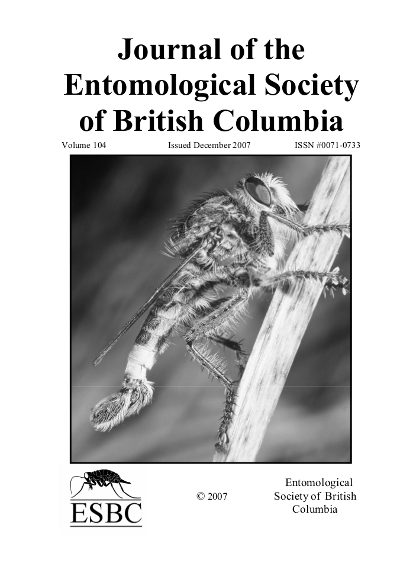Leafhopper host plant associations for <i>Anagrus parasitoids</i> (Hymenoptera: Mymaridae) in the Okanagan Valley, British Columbia
Keywords:
Mymaridae, Anagrus, parasitoids, leafhoppers, plant hostsAbstract
Anagrus spp. are important natural regulators of leafhoppers infesting grapes, tree fruits, and other crops in south central British Columbia (BC). Predominantly four species of these egg parasitoids, A. atomus (L.), A. avalae Soyka, A. daanei Triapitsyn, and A. erythroneurae Triapitzyn and Chiappini, were reared from dormant host plants and from summer host plants in the Okanagan Valley. The largest numbers of Anagrus specimens were collected from roses, Rosa spp; blackberry, Rubus spp; apple, Malus domestica; and other members of the rose (Rosaceae) family. Species of mint, family Lamiaceae, were important host plants for several species, with lavender, Lavendula angustifolia, and garden sage, Salvia oficinalis, being both a summer and winter host plant for some species. The most likely leafhopper host on these plants is the mint leafhopper, Eupteryx melissae Curtis. This study contributes to our knowledge of the biology of Anagrus species in south central BC and could contribute to future efforts to preserve or enhance populations of these beneficial insects.References
Agboka, K., A.K. Tounou, R. Al-Moaalem, H.-M. Poehling, K. Raupach and C. Borgmeister. 2004. Lifetable study of Anagrus atomus, an egg parasitoid of the green leafhopper, Empoasca decipens, at four different temperatures. BioControl 49: 261-275.
Beirne, B.P. 1956. Leafhoppers (Homoptera: Cicadellidae) of Canada and Alaska. The Canadian Entomologist 88, Supplement 2.
Chiappini, E. 1989. Review of the European species of the genus Anagrus Haliday (Hymenoptera: Chalcidoidea). Bollettino di Zoologia Agraria e di Bachicoltura, Serie II 21: 85-119.
Chiappini, E. and J. Huber. 2004. Fairyflies (Hymenoptera: Mymaridae), pp. 824-825. In Capinera, J.L. (Ed.), Encyclopedia of Entomology, vol. 2. Kluwer Academic Press, Dordrecht.
Chiappini, E., S.V. Triapitsyn and A. Donev. 1996. Key to the Holarctic species of Anagrus Haliday (Hymenoptera: Mymaridae) with a review of the Nearctic and Palearctic (other than European) species and description of new taxa. Journal of Natural History 30: 551-595.
Chiappini, E. and S.V. Triapitsyn. 1997. Redescription of Anagrus avalae Soyka (Hymenoptera: Mymaridae), with new synonymies. Frustula Entomologica 20: 119-126.
Doutt, R.L. and J. Nakata. 1965. Parasites for control of grape leafhopper. California Agriculture 19: 3-5.
Hamilton, K.G.A. 1985. Leafhoppers of ornamental and fruit trees in Canada. Publication 1779/E, Communications Branch, Agriculture and Agri-Food Canada.
Huber, J.T. 1986. Systematics, biology, and hosts of the Mymaridae and Mymarommatidae (Insecta: Hymenoptera): 1758-1984. Entomography 4: 185-243.
Kido, H., D.L. Flaherty, D.F. Bosch, and K.A. Valero. French pruce trees as overwintering sites for the grape leafhopper egg parasite. American Journal of Enology and viticulture 35(3): 156-160.
McKenzie, L.M. 1973. The Grape Leafhopper, Erythroneura ziczac (Homoptera: Cicadellidae) and its Mymarid (Hymenoptera) Egg-Parasite in the Okanagan Valley, British Columbia. M.Sc. Thesis, Department of Biological Science, Simon Fraser University, Burnaby, British Columbia.
Mulla, M.S. 1956. Two Mymarid egg parasites attacking Typhlocyba species in California. Journal of Economic Entomology 49: 438-441.
Pickett, C.H., L.T. Wilson, D. González and D.L. Flaherty. 1987. Biological control of variegated grape leafhopper. California Agriculture 41: 14-16.
Triapitsyn, S.V. 1995. The identities of Anagrus (Hymenoptera: Mymaridae) egg parasitoids of the grape and blackberry leafhoppers (Homoptera: Cicadellidae) in California. Pan Pacific Entomologist. 71: 250-251.
Triapitsyn, S.V. 1998. Anagrus (Hymenoptera: Mymaridae) egg parasitoids of Erythroneura spp. and other leafhoppers (Homoptera: Cicadellidae) in North American vineyards and orchards: a taxonomic review. Transactions of the American Entomological Society 124: 77-112.
Triapitsyn, S.V. 2001. Review of the Australasian species of Anagrus (Hymenoptera: Mymaridae). Belgian Journal of Entomology 3(2): 267-289.
Triapitsyn, S.V. and A.J. Teulon. 2002. On the identity of Anagrus (Hymenoptera: Mymaridae) egg parasitoids of Froggatt’s apple leafhopper, Edwardsiana crataegi (Douglas) (Homoptera: Cicadellidae), in Christchurch, New Zealand. New Zealand Entomologist 25: 91-92.
Trjapitzin, S.V., and E. Chiappini. 1994. A new Anagrus (Hymenoptera: Mymaridae) egg parasitoid of Erythroneura spp. (Homoptera: Cicadellidae). Entomological News 105: 137-140.
Vidano, C., and A. Arzone. 1982. Biotaxonomy and epidemiology of Typhlocybinae on vine, pp. 75-85. In Knight, W.J., N.C. Pant, T.S. Robertson and M.R. Wilson (Eds.), Proceedings of the First International Workshop on Biotaxonomy, Classification and Biology of Leafhoppers and Planthoppers (Auchenorrhyncha) of Economic Importance, London, 4-7 October 1982. Commonwealth Institute of Entomology, London.
Vidano, C., A. Arzone and A. Arno. 1987. Researches on natural enemies of viticolous Auchenorrhynca, pp 97-101. In R. Cavalloro (Ed.), Integrated pest control in viticulture. Proceedings of a meeting of the EC Experts’ Group, Portoferraio, 26-28 Sept, 1985, Amsterdam.
Williams, D.W. 1983. Ecology of a blackberry-leafhopper-parasite system and its relevance to California grape agroecosystems. Hilgardia 52: 1-32.
Williams, L., and T.E. Martinson. 2000. Colonization of New York vineyards by Anagrus spp. (Hymenoptera: Mymaridae): overwintering biology, within-vineyard distribution of wasps, and parasitism of grape leafhopper, Erythroneura spp. (Homoptera: Cicadellidae), eggs. Biological Control 18: 136-146.
Downloads
Issue
Section
License
Authors who publish with the Journal of the Entomological Society of British Columbia agree to the following terms:
-Authors retain copyright and grant the journal right of first publication with the work simultaneously licensed under a Creative Commons Attribution License that allows others to share the work with an acknowledgement of the work's authorship and initial publication in this journal.
-Authors are able to enter into separate, additional contractual arrangements for the non-exclusive distribution of the journal's published version of the work (e.g., post it to an institutional repository or publish it in a book), with an acknowledgement of its initial publication in this journal.
-Authors are permitted and encouraged to post their work online (e.g., in institutional repositories or on their website) prior to and during the submission process, as it can lead to productive exchanges, as well as earlier and greater citation of published work (See The Effect of Open Access).


